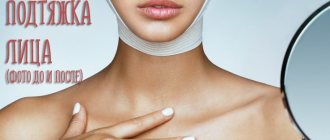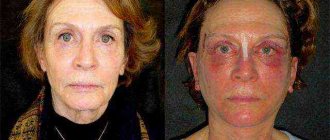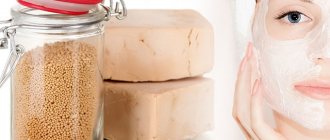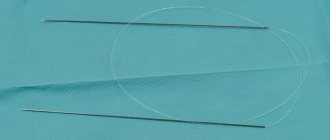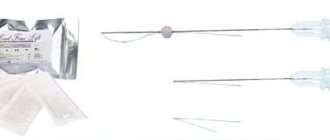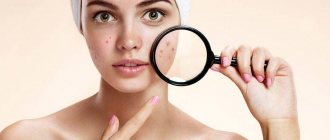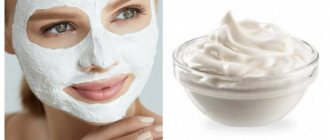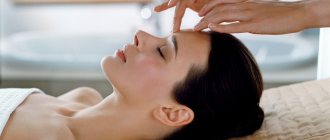A circular facelift will reduce the visibility of wrinkles, nasolabial furrows, and eliminate a double chin. The skin after surgery will become elastic and tightened.
Over the years, the skin, especially on the face, loses its elasticity and gets unwanted sagging. The wrinkled mesh appears more clearly and spoils the mood. But the aging process started by time will be stopped by a circular facelift - an operation that can rejuvenate the skin.
What can a circular facelift do?
A circular facelift (Rhytidectomy) is a surgical procedure that corrects age-related changes in the face. Wrinkles, double chin, nasolabial folds, etc. are removed. Not only does the skin tighten and its excess is trimmed, but also fatty tissue is removed and the muscles of the face and neck are tightened.
Wrinkles and folds appear due to the sagging of soft tissues, and the contours of the face lose their clear outline. Popular plastic surgery is aimed at eliminating the problem.
The following changes occur through a circular facelift:
- the previous contours of the face are restored;
- nasolabial furrows are smoothed;
- wrinkles on the cheeks are eliminated;
- the plasticity of the soft tissues of the cheeks is regenerated;
- patients get rid of double chin;
- a beautiful neck is designed;
- the shape and position of the eyebrows change or are partially corrected;
- drooping eyelids rise.
The results of surgical intervention are achieved by redistributing the skin, getting rid of excess skin, reconstructing the oval of the face, strengthening and stimulating the facial muscles.
The advantage of the complex method is that plastic surgery does not radically change the patient’s appearance. Freshness returns to the face and neck, and elasticity to the skin. And in one operation the client visually becomes younger.
Approaches for facial skin rejuvenation
The problem of aging is solved by modern cosmetic procedures. They significantly reduce the negative effects of stress, lack of sleep, unbalanced nutrition, and environmental influences. Changing the contours of the face will eliminate existing imperfections and prevent the formation of new ones. The procedure will hide obvious signs of aging, improve features, tighten sagging skin and deformed tissues.
Plastic surgery
SMAS – facelift allows you to strengthen the skin of the face and neck. The procedure significantly rejuvenates and restores the elasticity of the epidermis. The appearance improves, the person gets rid of age-related folds and sagging dermis.
The technology involves several stages:
- an incision from the edge of the ear to the back of the head;
- stretching fabrics, stitching;
- healing within 3 months.
It is important to know! During the frontlifting procedure, the upper part of the face – the forehead and eyebrows – is lifted. This eliminates the effect of sagging skin, folds, wrinkles, and gets rid of excess soft tissue over the eyelid, ptosis, asymmetry of the eyebrows, sagging in the temporal zone, and the corners of the eyes.
The lift is performed on patients over 40 years of age. Front lifting is carried out in one of three ways:
- An open radical procedure (involving incisions along the forehead behind the hairline).
- Endoscopic method (an endoscope with a microcamera is launched through small incisions, all manipulations are performed by the device).
- The use of endotins (fix soft tissues through implants that dissolve in the body).
If possible, plastic surgery is performed with a minimum number of incisions. This group of open methods includes the following:
- temporal lift;
- transpalpebral eyebrow lifting;
- direct brow lift.
Low-traumatic surgical interventions
Similar tightening techniques include endoscopic facelift, a minimally invasive plastic surgery recommended for minor signs of aging. During this period, the epidermis does not completely lose its elasticity and firmness. The procedure is carried out with special instruments that prevent damage to nerve endings and blood vessels. Skin tissue is not excised. Incisions are made in the oral cavity, frontal and temporal areas of the face. Rehabilitation takes 10–15 days, which is considered a short recovery period.
Lifting facial contours using dissolving and non-dissolving threads (thread facelift) occupies a separate niche among alternatives to plastic surgery. The cosmetologist creates microscopic incisions into which thin, tensioned threads are implanted. The procedure lasts several hours, the effect appears after a month. During this period, the connective tissues grow together with the injected drug. The rehabilitation time is 3–5 days.
Such an intervention tightens the skin of the neck, corrects nasolabial folds, fine wrinkles and other imperfections. After lifting, complications may occur: hematomas, short-term asymmetry, pain.
Facebook building
The technique affects the anatomical volumes of the face by stimulating muscle tissue and includes special gymnastics and massage techniques.
Advice! If you do the selected set of exercises regularly, the oval of your face will be restored and the signs of gravitational ptosis will be eliminated. Exercises will lead to the removal of puffiness, reduction of dark circles under the eyes, and improve the color of the skin.
The movement of blood in the tissues will accelerate, the relief of the epidermis will resume. The photo shows the results of using well-known “facial structure” techniques.
Fitness trainer Galina Dubinina combined breathing exercises, acupressure and facial exercises in one lesson. The complex is performed daily for 3–4 weeks. It leads to improvement of lip contour, elimination of fine wrinkles, and removal of swelling. The exercises are repeated 10–15 times; in case of severe pain and tension, rest. In case of cramps, they return to gymnastics after a few hours or the next day.
Facial training from Alena Rossoshinskaya gives significant results if all recommendations are strictly followed. Exercises will help restore color to the skin, remove small folds, and tighten contours. Gymnastics is based on several principles:
- Apply the fingers to the skin with moderate force. Massage should not create a feeling of discomfort.
- Actions are monitored using a mirror. Observing yourself will help you avoid mistakes.
- A certain time is allotted to complete the course so as not to be distracted. The optimal period for training is in the morning, 1 hour before bedtime. The procedure is repeated 2 times a day for 3 weeks.
- Attention is focused on problem areas. You can spend more time on them.
- If you feel unwell, workouts are postponed. Contraindications include high temperature, fatigue, and viral diseases.
Benita Cantieni proposed a phased implementation of Facebook building. During preliminary preparation, they improve posture, revitalize facial muscles, and learn to control them. Meditation is practiced to create a suitable atmosphere. During targeted training, active points are affected. They are stimulated through increasing strength loads. The complex includes 13 exercises, each of which takes about 2 minutes.
Evgenia Baglyk has developed a universal course that can be used by men and women. With its help, they eliminate excess fat deposits, correct the skin after losing weight, and get rid of sagging cheeks. The face takes on a fresh look and returns a healthy color. The tissues become more elastic and sagging is lost. Special fitness tightens the contours and smoothes out deep folds.
The key to success in a facelift through gymnastics is the systematic and precise execution of the exercises. After 1–2 months, the results of a rejuvenated appearance will become visible. In the future, it is possible to achieve a long-lasting effect and look 5-7 years younger. According to customer reviews, after a full course of training, the skin becomes firmer, healthier, and more elastic. In some cases, the shape of the lips changes, and the area of the neck and forehead can be changed. The technique is used regardless of the gender of the person.
Hardware lift
Laser lifting successfully combats epidermal defects with minimal damage. This type of lift affects the superficial and deep layers of the dermis. The procedure is performed without surgery, with general anesthesia. It is used in the early stages of aging. The laser beam burns dead, keratinized cells. The device restores the processes of skin regeneration and the production of its own collagen and elastin fibers. Positive results of the intervention include:
- short rehabilitation period;
- the possibility of performing lifting in a cosmetologist’s office;
- low level of injuries.
The result will appear within 6 months after the procedure; in some cases, pigmentation disturbances are observed. In patients with thick skin, the effect is less noticeable.
Ultrasound lifting is considered a non-surgical technique for improving facial contours. Waves of a set frequency are directed to the epidermis, activating the muscular aponeurotic system. In this way, the skin in the area of the nasolabial folds is smoothed and the double chin is reduced. The facial oval is transformed and acquires clear lines. The corners of the lips rise, the cheeks tighten. The non-surgical technique is effective for 5 years.
It is important to know! “Vampire” facelift – injection of a mixture based on human blood products. The substance is used to treat areas of the face and neck burdened with wrinkles. After the procedure, the skin is lightened and its imperfections (scarring, acne) are eliminated. The epidermis is saturated with platelets, which affect rejuvenation.
To carry out the tightening, the patient’s blood (or rather, plasma isolated from it) is used to eliminate the risk of rejection and infection. You can evaluate the results of such a facelift using reviews and photos of patients before and after the session.
Contraindications for a circular facelift
A circumferential facelift should not be performed on those diagnosed with the following diseases.
CONTRAINDICATIONS
- tumors – benign and malignant;
- infections;
- impaired blood quality, including coagulopathy;
- exacerbation of chronic diseases;
- endocrine disorders, including diabetes mellitus;
- hypertension.
Among the contraindications is a tendency to keloids. But only in the case of a surgical circular facelift. The limitation is not relevant for laser and radio waves.
Preparation for plastic surgery (rhytidectomy)
Circular facelift is well tolerated by patients of different ages. And even those who are 80 years old manage to safely undergo surgery and recover from the operation without harm to their health.
But plastic surgeons say that the likelihood of a successful result is higher for those older women who are not burdened with excessive excess weight.
Although, despite the appearance of wrinkles and sagging skin, their epidermis remains quite elastic.
The patient begins to prepare for a circular lift 2 weeks in advance. It consists of abstaining from:
- alcohol;
- medicines;
- smoking.
24 hours before surgery, heavy foods are prohibited, and it is recommended to eat dietary foods in small quantities. On the day of surgery, patients do not drink or eat anything.
A serious attitude towards the preparatory period ensures a favorable outcome of the operation.
How is the operation performed (step by step)?
A competent plastic surgeon will not begin work without studying the results of a patient’s medical examination. This helps the doctor make sure that the client has no contraindications to plastic surgery.
The specialist plans the choice of surgical technique (open classical approach or endoscopic) when examining the patient, based on the state of ptosis and a number of other indicators.
Ritidectomy (also called a circular facelift) is performed under general anesthesia in the following sequence:
- The surgeon makes an incision in the temple area and ends it near the auricle.
- The doctor who goes around the earlobe continues the incision to the back of the head, thereby promoting the detachment of the skin of the cheeks, chin, neck, and temples. By redistributing the skin, the plastic surgeon achieves beneficial movement of the facial muscles, epidermal tissue and fat deposits.
- After that, the doctor applies special tightening, which helps fix the skin in the required position. Smas-plasty achieves skin tension. The surgeon can only remove excess fat and fix the result with a suture using special threads - they eliminate the appearance of scars.
- To secure the skin and muscle tissue, the doctor also makes an incision under the chin.
By performing a one-time operation, rejuvenation of both the face and neck is achieved.
A new trend in world practice is Fiber Glue, a special glue for better healing and “growth” of the skin after Smas lifting.
Surgical lift
The news that surgery is necessary to effectively lift the neck and lower third of the face has long ceased to shock patients. Many people are aware that there are modern minimally invasive techniques, rehabilitation after which lasts only a few days.
Going under a scalpel is always unpleasant. But now it is practically safe and guarantees excellent results.
Advantages and disadvantages
The main advantage of surgical lifting of the lower third of the face is the almost immediate result. Of course, it will be possible to examine it only after the swelling goes down. But an experienced surgeon, after completing the work, understands how successful the operation was.
Also, the advantages of the surgical technique are:
- the ability to remove excess skin and fat;
- successful correction of even deep expression wrinkles;
- lack of constant contact with strong drugs;
- minimal damage to the epidermis;
- long-term preservation of the results obtained.
There are also disadvantages. Surgery is always associated with risks of complications. An experienced specialist simply reduces them to a minimum. The list of contraindications to radical intervention is quite long. The rehabilitation period, although short, is also present and is best spent at home.
Anesthesia is not very useful, although the lift is often done under local anesthesia. Pain is also a deterrent for many, but it usually occurs only within a few hours after surgery.
Preparation
No doctor will perform a surgical lift in the lower third of the face without first examining the patient. It is necessary to identify possible contraindications and prevent the development of serious complications.
The standard procedure includes:
- chest x-ray;
- general urine and blood tests;
- tests for HIV and syphilis;
- coagulogram;
- electrocardiogram;
- blood pressure measurement;
- determination of sugar level.
If the tests are normal, a preliminary consultation is held with the patient, at which all the details of his request are clarified and the optimal form of the operation and type of anesthesia are selected.
A week before the procedure, stop taking antibiotics and anticoagulants and drinking alcohol. It's better to quit smoking at the same time. You must go into surgery on an empty stomach if general anesthesia is used. Before the local one, you can have a snack 2-3 hours before the procedure and drink some water.
Methods of execution
Today, there are several effective ways to perform surgical lifting of the lower face area:
| Way | Description |
| Classical | Work is performed only on leather. It is cut at the back of the head, near the ears and under the chin, tightened evenly, the excess is excised and the wounds are tightened with neat sutures. Everything is the same as it was 20 years ago, except that a regular scalpel has replaced a laser one. |
| SMAS lifting | It differs from the classics in that the muscles are tightened first. Access to the working area is through a small incision in the behind-the-ear area. Muscles that have lost tone are pulled up, fixed in the desired position, and only then covered with skin. This allows you to renew the natural frame and creates an excellent rejuvenation effect without distorting facial features. |
| Endoscopic | In this case, the scalpel is used exclusively for small (up to 1-2 cm) skin incisions, through which a device equipped with a video camera is inserted and allows for very subtle manipulations. This operation causes minimal tissue trauma and virtually eliminates the risk of damage to nerves and large blood vessels. It also significantly shortens the rehabilitation period. |
| Installation of endotins | Fixation of muscles and skin is performed using the thinnest plates of biodegradable material with small teeth. They are inserted through small incisions and attached to the bones of the skull. Then soft fabrics are hung on them. This allows you to securely fix them in the desired position for a long time. |
| Thread lifting | The least traumatic of all invasive methods. A facelift is performed with self-absorbing threads, which are installed through thin long cannulas. They usually also have knots or notches to better hold the skin. The main advantage of bioreinforcement is the complete absence of seams. But due to the use of anesthesia and punctures, it is still considered a gentle operation. |
The decision about which of these methods will be optimal for the patient is best left to the doctor.
Rehabilitation
The period of active recovery after using these methods varies: from several days to 2-4 weeks (with the classical method). During this period, certain prohibitions and restrictions apply, which the cosmetologist talks about in detail. Following his recommendations allows you to avoid the development of serious complications and unwanted side effects.
It is very important to prevent wounds from becoming infected and not picking up any virus . The immune system after surgery is always weakened and does not need additional stress at all.
Usually the doctor sets a date for a follow-up examination, which you must attend. You should worry if the following problems appear:
- significant increase in body temperature;
- long-lasting swelling;
- pain and redness;
- suppuration or constant discharge from wounds;
- signs of tissue necrosis;
- postoperative bleeding;
- divergence of seams.
In these cases, you must go to the surgeon immediately, without waiting for the appointed date. Perhaps the infection has nevertheless entered the body and can provoke the development of serious complications.
Contraindications
SMAS lifting of the lower third of the face and other types of surgical lifting cannot be performed if:
- pregnancy and during breastfeeding;
- serious disorders of the liver and kidneys;
- severely reduced immunity;
- cardiovascular failure;
- oncological, autoimmune and systemic diseases;
- the presence of active viruses and infections;
- skin diseases in the work area;
- respiratory diseases;
- diabetes mellitus and severe hypertension;
- poor blood clotting;
- exacerbation of chronic ailments;
- tendency to form keloid scars;
- epilepsy and mental disorders.
Ignoring these contraindications can lead to very negative consequences. Therefore, during the preliminary conversation, the doctor’s questions about the state of health must be answered as honestly as possible and “fake” test results should not be brought.
Types of circular facelift
There are 2 variations of the procedure. The main types of circular lifting include: SMAS (considered a classic) and MAX lifting SMAS (superficial muscular aponeurotic system or muscular aponeurotic layer).
Moreover, only by “raising” this layer problems are solved:
- “bulldog cheeks”;
- pronounced nasolabial fold;
- double chin.
Skin tightening for facial ptosis with these types will not give the desired result. Therefore, for patients 35-55 years old with slight ptosis of facial tissues, a MAX (minimal access cranial suspension lift) type operation or minimally traumatic SMAS through small incisions is recommended.
It is worth highlighting 2 more types of lifts:
- Check-lifting. A facelift is being performed. The doctor cuts the skin under the lower eyelids.
- Endoscopic lift. In this case, an endoscope is used, which is inserted under the skin through small punctures, which is an advantage of the manipulation.
Rhytidectomy cannot be done without surgical intervention. A number of cosmetic measures, often called a “circular facelift,” do not guarantee a long-term facelift and do not allow you to look 10 years younger.
Temporal lifting
Temporal lifting is another modern method of endoscopic lifting of the midface. When performing such plastic surgery, incisions are made in the temporal part of the head, laterally (inside the mouth) and along the lower eyelid. Until recently, the main disadvantage of temporal lifting was the inability to adequately correct ptosis of the cheek tissue. The result was not entirely natural due to the point fixation and incomplete coincidence of the vector of tissue movement (from below diagonally, towards the temple, and not exactly against the direction of age-related ptosis, which always moves tissue from top to bottom). The temporal lifting technique was reborn with the development of endotins. Their use made it possible to achieve the main effect - to obtain a harmonious and natural result when lifting the cheeks.
Compared to a check-lift, this operation is more invasive. Its duration is about 2 hours. The recovery period is also longer – 3-4 weeks. For several months after surgery, endotins, which fix the tissue, can be felt under the skin. Then the tightened tissues take root in their new position, and the endotins are completely absorbed.
More information about SMAS lift
SMAS is an abbreviation for superficial muscular aponeurotic system. This phrase translates as superficial muscular aponeurotic layer. It is he who preserves the contour of the face and protects against sagging.
But over the years, the properties of this layer are lost, wrinkles and sagging skin appear.
During the operation, not only the skin is tightened, but also the deep layers underneath it. This is a deep lift with which you can achieve amazing results.
With the help of SMAS lift you can achieve the following positive changes:
- return to normal position of the facial frame;
- smoothing out wrinkles;
- oval improvement.
Surgery can be combined with other cosmetic procedures.
The surgeon performs the procedure under general anesthesia. Initially, he makes an incision starting from the temple along the line where the hair grows. The skin is cut to the back of the head.
Such information seems terrifying, but, despite the considerable incision, in the future the seam is almost invisible to others.
Through such incisions, the surgeon tightens the skin and aponeurotic layer. If required, it removes unnecessary skin and fat.
There are two types of SMAS lift. You can simply tighten the aponeurotic layer, or you can detach it, which shows an excellent effect, but the risk of encountering trouble increases.
MACS-lifting
MACS lifting is a surgical procedure with a minimal incision. The operation is quite similar to the previous method, but in this case the person is subject to less trauma.
This type of lift is recommended for people under 40 years of age with mild age-related changes.
With the help of MACS lifting, you can make the skin more elastic, improve the contour, tighten the corners of the mouth, and remove creases in the nasolabial area.
The doctor cuts the skin starting from the earlobe, moves in front of the ear and ends at the temple. Only the skin is peeled off without affecting the SMAS layer.
Swelling will be present at first, but will finally subside in approximately 2 weeks. The sutures are removed on the 9th day.
Who will it help and how?
A facelift is suitable for those who have certain problems with their facial skin. These are mainly age-related changes, but this rejuvenation technique is often used by people who have other problems. The indications are as follows:
- a large number of wrinkles, facial, age;
- problems with skin elasticity;
- strong pigmentation;
- bad color;
- presence of a double chin.
The lifting procedure is very effective and completely painless. It helps to get the following results:
- increase skin elasticity;
- deeply rejuvenate, improve the health of the dermis, consolidate this effect for a long time, activating collagen production;
- increase the amount of elastin;
- smooth out wrinkles;
- remove double chin;
- get rid of age spots;
- remove flabbiness, peeling, irritation, yellowness, grayness of the skin;
- achieve clearly defined contours.
- Cervical dysplasia - what is it: treatment and extent of the disease
- Megafon SIM card blocking
- Baked apples in the oven: recipes
Rehabilitation period
During the postoperative period, tanning under the sun and in a solarium is prohibited for a month.
In the first 2 weeks after rhytidectomy, there is a taboo on visiting the bathhouse and sauna. You cannot use caring and decorative cosmetics for 2-3 days.
People who apply for such plastic surgery note the expressively defined contours of their cheeks and neck. At the same time, the chin and cheekbones become sharper, adding elasticity to the skin.
The result is observed after some time specified for rehabilitation.
Immediately after the procedure, the tissues become swollen. Extreme edema is located in the paraorbital zone.
Postoperative swelling occurs due to damage to the integrity of the lymphatic vessels and the body's response to the inevitable tissue rupture. As a result, inflammation begins to develop.
In order to avoid separation of the suture edges due to tissue swelling and to provide the patient with comfort during the rehabilitation period, the surgeon applies a compression bandage in the operating room.
After 5 days, the swelling will go away, provided that the rules for successful rehabilitation are followed. Any postoperative pain and discomfort that occurs can be relieved with the help of conventional painkillers.
Sometimes during the rehabilitation period a person is bothered by an unpleasant, pulling sensation at the site of the incision. Tingling and numbness occur against the background of altered tension and decreased volume of the skin.
The discomfort will disappear as the swelling decreases, the skin tissues and muscles will get used to the new condition.
If rehabilitation is successful, the sutures are removed on the 2-3rd day. Their place will be taken by the strip strips provided for the postoperative period.
A properly performed circular facelift does not leave visible scars. Thin and jeweled stitches are visible only to the surgeon.
The average rehabilitation period is 1-2 months. It depends on the age and health of the client, the revitalization of recovery processes in his body. Therefore, the duration of rehabilitation will vary from patient to patient.
Types of injections for facelift
For the injection method of lifting the oval face, special cocktails are used that form clear facial features, highlight the chin and cheekbones, eliminate fine and deep wrinkles, and add elasticity to the skin.
The following groups of substances are used for injections.
- 1 group. Gels of synthetic origin that have a long-lasting effect. Such preparations include biopolymer gel, silicone-1000, outline and others. It should be said that such substances are losing their popularity every year, as they have many nuances when used. If necessary, they can only be removed from the body surgically. There is also a risk of the gel shifting under the skin after a few years.
- 2nd group. Preparations of biological origin or biocompatible purposes. These include polylactic and hyaluronic acid, natural collagen. Such substances can dissolve on their own, providing safety for the patient’s body.
- 3rd group. Combination preparations. Such substances are presented as a gel of biological origin in combination with synthetic fillers.
What complications occur?
The list of expected unpleasant consequences includes:
- injury to the facial nerve, which can lead to disruption of the innervation of the muscles responsible for facial expressions;
- asymmetry of the face or hyperextension of the skin surface due to erroneous fixation of the epidermis and muscles;
- applying wide stitches, then the scars on the face will appear;
- The formation of keloid scars occurs due to improper preoperative examination or the characteristics of the patient’s body.
Plastic surgery is a serious procedure, so careful preparation for it cannot be ignored. A high-quality examination and the competence of the surgeon will allow you to obtain the planned result.
Non-surgical circular lift
In case of fear of surgical intervention, patients use non-surgical techniques using laser, threads and radio waves to combat aging. A circular facelift performed using one of these methods is quite effective.
Not every patient is allowed to use the procedures. If ptosis or deep furrows are clearly visible on the face, atraumatic measures will not remove wrinkles or tighten the skin.
Each non-surgical treatment has its own characteristics.
- Radio wave procedure. It is performed under local anesthesia. In the problematic area, electrodes are inserted through miniature holes to distribute impulses. The waves trigger internal processes aimed at generating beneficial components, activating metabolism and rejuvenating soft tissues.
- Skin tightening with threads. The procedure also involves mini-incisions. To perform the manipulation, the use of absorbable and permanent materials is provided. With the first method, the lifting effect is acquired through physical maintenance and breakdown of the introduced product into useful components. They cause the restoration of internal processes. Threads made of constant materials cope with tightening only by their presence. The peculiarity of the second method is that after time the patient needs adjustment and secondary tension.
- Laser facelift. With this procedure, the integrity of the skin is not compromised. The epidermis and medial parts of the skin are treated with a laser beam at a temperature selected for manipulation. The process affects the activation of the production of collagen, proteins and elastin, which, in turn, increase the tone and plasticity of the turgor.
Non-surgical circular facelift is characterized (compared to surgery) by simple rehabilitation, lower cost and minimal negative consequences. But its effectiveness does not last long.
Face lifting at home
At home, a facelift is performed using cosmetic methods similar to salon ones. To get a long-lasting effect, special masks are made, massages are made to tighten the skin, creams with a rejuvenating effect are applied, certain gymnastics are performed, exercises for the facial muscles, and tightening devices are used. The improvement does not come as quickly as after salon procedures, but after a while the wrinkles are smoothed out, and the result lasts for a long time.
Masks
Using homemade masks helps smooth and soften the skin. Tighten it up, even out the complexion. Popular masks include:
- Ovale Lifting by Yves Rocher. The mask has a smoothing, softening, moisturizing and nourishing effect. Perfectly evens out the complexion, relieves redness, and does not clog pores.
- Orange Lift Mask from Mesopharm. The film mask acts in several directions: it hides age, exfoliates the top layer, and tightens the dermis.
In addition to ready-made masks, there are recipes for special cosmetics that give the same effect. This:
- Egg white mask with 1 tablespoon of lemon juice. The well-mixed mixture is applied for 20 minutes and washed off with warm boiled water.
- A mixture of banana, 50 ml of cream, 1 capsule of vitamin E. The mixed composition is applied for 20 minutes, then removed using a cotton pad soaked in warm water.
Creams with rejuvenation effect
Light cream formulations have a good effect. Among the most popular:
- Total-Lift Light Cream from Swiss line. Suitable for combination and oily skin, it tightens well and helps smooth out wrinkles.
- Swisscode by Genistein. This is a whey containing large amounts of soy isoflavones. In terms of productivity, the action can be compared with high-tech cosmetic procedures.
- Le Son Noir by Givenchy. A cream containing seaweed extracts restores and protects the epidermis.
Skin tightening massage
Cosmetic massage is performed using a vacuum cup, which promotes good blood circulation. This happens as follows:
- Problem areas of the skin are treated with cream or oil.
- The jar is brought to the skin, placed on the desired treatment zones so that it sticks (if you feel a little pain, then everything was done correctly).
- Circular movements are made on problem areas.
There are several types of facial massage. Each of them has a specific effect:
- modeling – deeply affects the facial muscles;
- sculptural – consists of standard methods of influence (claps, stroking, pinching);
- plastic - based on short, quick movements directed to the ears from the chin, nose, to the temples from the middle of the forehead;
- Japanese – impact on areas and points of the face;
- Chinese - general health effects on acupuncture points.
Gymnastics and exercises
A good option for modeling the contour of the face is gymnastics and exercises. The only requirement is to do them regularly. The types of exercises are as follows:
- For the chin. Performed: tilt your head up, stretching your lips, hold for 30 seconds. Do 3 approaches.
- For lips. Elongated cheeks, lips linger for 5 seconds. So 10 times.
- For cheekbones: air is inhaled and rolled from one cheek to the other. Hold for as long as possible, repeat 5 times.
- For the forehead: use your index fingers to move your eyebrows up and down. Do for one minute.
Home lifting devices
To carry out RF lifting at home for the face and body, we recommend a 5 in 1 device – ReadySkin nanoSkin. It is easy to use and easy to transport. The device starts the process of collagen production in the body, which lasts several months. At the end of the course of procedures, the result increases and the skin condition improves.
Users note:
- beneficial effect on muscle tone and epidermis;
- increasing skin firmness and elasticity;
- reducing the depth of wrinkles and reducing their number;
- eliminating bags under the eyes;
- reduction and smoothing of chin and nasolabial folds;
- skin color and tone improves.
The Darsonval apparatus is used in many healing techniques. Electrodes inserted into the device come into contact with the skin and affect problem areas of the face. As a result:
- the skin becomes firmer and more elastic;
- the chin is tightened;
- the functioning of the sebaceous glands is normalized;
- color improves;
- Acne and scars disappear.
The device requires its use according to specific instructions. The rules are as follows:
- The treated areas must be clean and dry.
- The installed electrode must be pre-treated with alcohol and dried.
- Remove all metal jewelry.
- The device is used in courses, each with 10-15 repetitions.
- Signs of pregnancy
- Carp baked in the oven: how to cook fish deliciously
- Whole chicken in the oven: recipes with photos
The ESMA device is a physiotherapeutic equipment that is used for myostimulation. The device copes well with swelling and “orange peel” skin. As a result of radiation, lymph flow and blood circulation improve. Facial myostimulation is performed when:
- sagging skin;
- facial wrinkles;
- double chin;
- the presence of local fat folds.
ESMA suggests using it in several stages. One course consists of 10-15 procedures a couple of times a week. Then you can do the procedures once a month. The sequence of use is as follows:
- make-up remover, peeling if necessary;
- treatment of the contact area with a special conductive gel;
- use of electrodes (stationary or mobile);
- supply of current of a certain amplitude and frequency;
- applying a mask or cream appropriate to your skin type.
Question answer
There are no restrictions as such. But surgery is recommended at the age of 40-65 years. The fact is that younger people can benefit from other rejuvenation techniques. But after 65 years, you can encounter complications, because the skin is no longer capable of normal regeneration. Although in plastic surgery there are many cases of successful such manipulation for those who are 70 or 80 years old.
This intervention will take 1.5-4 hours. It all depends on the individual characteristics of the patient and the amount of work.
At 25-35 years old, a person is still young enough to think about a circular facelift. A more reasonable alternative may be a “mini facelift.” You can also lean towards other correction options: the introduction of fillers (for example, Juvederm, Restylane), botulinum toxin preparations, laser rejuvenation, radio wave lifting, photorejuvenation, darsonvalization, etc.
Cost of a circular facelift
The cost reflects the type of procedure, the rating of the clinic and the region of its location. In Moscow and the region, the price for rhytidectomy ranges from 200 thousand to 300 thousand rubles.
Surgical circumferential facelift is recognized as a high-cost procedure. The price often includes:
- consultation with a plastic surgeon;
- preliminary and final diagnostics;
- possible visits to doctors of other specializations;
- general anesthesia;
- antiseptic preparations and materials for sutures;
- recovery medications;
- being in a hospital inpatient setting.
Laser manipulation starts from 10 thousand rubles, facelift with threads – from 20 thousand rubles. Lower costs (from 8 thousand rubles) will be incurred by the patient who applies for radio wave lifting.
This is due to the use of local anesthesia and the lack of hospital stay in terms of recovery. When choosing, you should analyze the pricing policies of several clinics in the region.
Thread and vector lifting:
Thread lifting is a method of tightening and lifting the soft tissues of the face using special self-absorbing caprolactone threads (Aptos, Dermafil). One-sided notches on the threads provide lifting of sagging areas of the face, while the introduction of threads under the skin occurs unhindered. The threads dissolve within 9-12 months, but as the threads dissolve, they are replaced with their own fibrous tissue, due to which the effect of a thread facelift lasts up to 2-5 years. Indications: eyebrow lifting. elimination of soft tissue ptosis, double chin, elevation of the cheek areas. The procedure is performed on an outpatient basis under local anesthesia, does not require long-term rehabilitation, and you can maintain your usual lifestyle.
Vector lifting with fillers - fillers are injected intradermally in the form of parallel vector lines along which the skin is tightened. Indications: mild to moderate ptosis, modeling and lifting of small areas of the face (zygomatic, eyebrow corners, cheek fat pads). During the vector lifting procedure, fillers of hyaluronic acid or calcium hydroxyapatite (Radiesse) are used - depending on the drug used, the effect can last from 6 months to 3 years.
Reviews
ZOYA:
“I had a circular facelift and am happy with the result. At 45 years old, I look 35, as can be seen from the before and after photos (by the way, the price in Chelyabinsk is much lower than in Moscow).
She's younger and prettier! My husband is jealous and worried because young guys are also looking at me. I advise: if your health allows, it’s worth taking the risk.”
IRAIDA:
“The decision to undergo surgery must be made with the guidance of the doctor. Because not everything that is expensive is good. The plastic surgeon I trusted does not charge the highest price in our city (Novosibirsk), but I was impressed by the before and after photos of his work. The result is amazing. I'm 15 years younger now. By the way, the price also includes a chin implant.”
ANGELA:
“My mother had Smas done by a specialist in Krasnodar, recommended by friends. Although the operation is not easy, the rehabilitation is not short, but the result is magnificent! Mom looks like candy, her youth has returned to her.”
NINA:
“4 months have passed since Smas. But the expectations were not met. The result is deplorable, because... I have terrible asymmetry, my eyes are not the same and at different levels. The nasolabial lips also remained in the same place. I didn’t look younger, but got an ugly face for a lot of money. I probably fell for an unscrupulous surgeon, as I read reviews and forums of other women who were satisfied.”
Top 3 hardware methods of face lifting
Advanced clinics around the world offer a wide choice for those who want to avoid invasive (surgical) lifting methods. We will name the first three most popular, and therefore most proven, hardware facelift methods.
Radio frequencies
About 5 years ago, radio frequency (RF) lifting was a real hit, but even today this method is offered in many clinics and SPA centers. Initially, such therapy was not used at all to preserve youth, but as a treatment for snoring.
The procedure is simple, quick and painless - the patient only feels relaxing warmth in the areas where the device is applied. Radio frequencies affect subcutaneous fat, melting it. Due to this, a tightening effect is observed. After just 2 days, the face becomes noticeably younger, and the result lasts for a month. The procedure helps improve the appearance of the skin, removing unevenness and wrinkles.
RF lifting can achieve more significant results on the skin of the body. Patients are pleased with the very quick tonic effect. Clients say that after the radiofrequency procedure, their buttocks almost immediately look like they were doing 500 squats every day. The tightening effect on the body can last longer than on the face - up to 2 years!
Laser
Laser hardware cosmetology has a good reputation among clients of anti-aging clinics. Initially, the procedure was carried out only to remove various skin defects, such as scars, scars, papillomas, etc. But today such devices are widely used for face lifting.
During the procedure, the skin is exposed to rapid pulses of laser radiation. Getting into the depths of the epidermis, the laser evaporates cells damaged by fat and activates collagen production. At the same time, the patient feels some discomfort - a feeling as if they are being “shot” with an elastic band, but the unpleasant reactions go away after a few minutes.
It may take time to see the desired results because laser lifting is designed to stimulate the growth of natural collagen bonds. As a rule, new collagen grows in the skin after a few months, and a noticeable rejuvenating effect appears after 90–180 days. The results of laser tightening last up to 2 years.
Ultrasound
Ultrasound can truly be called a real replacement for surgery. Since 2009, this hardware method has been used for facial lifting; it is truly capable of affecting that same SMAS framework, and therefore giving the necessary results. The disadvantages include the high price and pain. But only ultrasound allows you to penetrate as deeply as a surgeon’s scalpel can, unlike laser and radio frequencies.
Ultrasound allows you to reach the same layers under the skin as surgical lifting
Comparing different hardware facelift methods gives a complete picture and helps you make an informed choice. And he will most likely undergo ultrasound, because this procedure is the most effective. The price, of course, will tell you “no”, but you will have to choose what is more important to you: the result or the savings.
Table: comparative analysis of popular hardware methods of face lifting
| Hardware method of circular tightening | Penetration depth | Rehabilitation period | Price (average for Moscow clinics, 2020) | How long does the lifting effect last? |
| RF lifting | 3 mm | 2–3 days | $100–150 | On the face – 1–2 months |
| Laser | 1–1.5 mm | Few hours | From 450 to 2 thousand dollars | Up to 2 years |
| Ultrasound | 4.5 mm or more | No more than 1 hour | From 1 thousand dollars and above | 2 years |
Expert opinion
- Cosmetologist
- Surgeon
Irina Dorofeeva
practicing cosmetologist
I would recommend not to rush into a circular facelift. First, you should turn to cosmetic procedures: mesotherapy, laser rejuvenation, etc. When these methods prove powerless, then you should think about more radical methods. But rhytidectomy is an excellent opportunity to rejuvenate your face by ten years.
Sanas Kharirchyan
plastic surgeon
As practice shows, this operation is usually performed on women after 40 years of age.
I recommend using a compression bandage after the intervention. It will help reduce swelling and recover faster. People who ignored this rule often encountered complications and increased their rehabilitation period. SMAS-lifting is especially relevant now. But there is no need to perform a circular lift more than 2 times. Otherwise, there is a risk of changing your face beyond recognition. A circular facelift will make you look 5-10 years younger. Painlessness of rhytidectomy is ensured by general anesthesia, and postoperative complications are minimized.
